 Facebook
Facebook
 X
X
 Instagram
Instagram
 TikTok
TikTok
 Youtube
Youtube

When the timing is right— when the sun and moon affect light and tide; when the wind and swell affect clarity — the ocean tilts herself to me, and from my perch just 20 feet above and less than a hundred feet away from the high tideline, I can see into her as though peering into an aquarium. I have seen small halibut scurry up and down in the clean face of a shore break, and I have seen what was maybe corbina or yellowfin croaker bolt sideways and out and away. Once, a sea lion and I exchanged glances through the glassy face of a wave before the wave broke and our moment was shattered into shards of white crystal.

Pelicans cruise the surf zone, tucking in tightly along the valleys between the whitewater of the last broken wave and turquoise crest of the next with an aerial accuracy usually only ascribed to aces such as the Blue Angels. It’s when the pelicans suddenly rise, fold their wings and fall ungracefully into the water with beaks open to scoop a baitfish and come up ass over tea kettle that my heart skips a beat. I will often grab the binoculars and watch around them and outside a little, in the deeper water behind the shore break, looking for any inkling of activity from the pelican’s underwater counterparts that also skillfully cruise the shoreline to feed; rarely California yellowtail, more often bonito and halibut. Seasonally, shortfin corvina, California corbina, and yellowfin croaker also cruise within casting distance of shore.
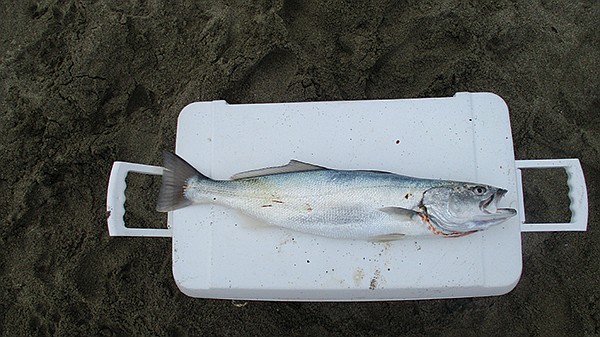
Rods at the ready and binoculars to help with spotting activity. Not a bad way to spend a day.
Since arriving here in Bahia Asunción’s bay side on November 6, I’ve caught dozens of bonito and halibut from the beach. Both species have been small — the bonito maybe to a pound and a half, halibut to 20 inches. As there is no minimum size on the halibut in Mexico, I have eaten a couple in that 18- to 20-inch range. The fillets were thick for their size, the fish having fattened up on the plethora of bait that holds along shore just behind the breaking waves.
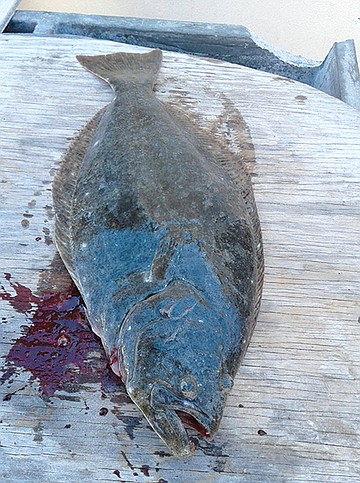
Bahia Asunción lies about 515 miles from San Diego, south of the Baja Sur/Baja Norte border. It’s on the south side of the rose thorn-shaped peninsula that juts out from the Pacific side of Baja about halfway between Cabo San Lucas and Tijuana. Folks here prefer their halibut for table fare in the 18-inch size range. One fish will make a basket full of tacos or fillets perfect for a family of four’s main course. For me, there is that feeling of guilt — a fleeting guilt, as I love eating halibut — due to taking a "short." I haven’t always applied California DFW size and catch restrictions while fishing in Mexico, but I do try. Mexico has bag and species limits and license requirements. Following the rules of the fishery in which one is fishing is strictly advised. As for eating a foot-and-a-half halibut, "when in Rome...."

The first time I was here in this little fishing co-op town in Baja California Sur was this past September. I stayed for a few weeks on the sea side of the point and concentrated on calico bass, of which I caught the most and largest that I have in a long time. I caught a yellow within jig stick distance from shore. I fished primarily from my kayak, which I would launch from a sheltered cove just two hundred yards from the Sunset Casita I had rented from Shari Bondy and Juan Arce of La Bufadora Inn. I caught the small five-pound yellowtail while slinging plastics near boiler rocks along the coast.
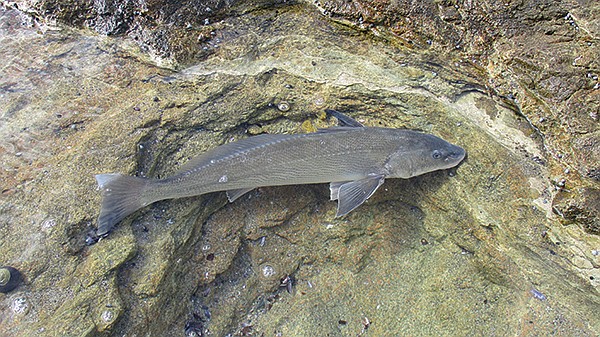
Here, on the bay-side of the point, I have walked the beach, rod in hand, with my dogs Flash and Taz following along, and the lobos, the dogs of the sea, will be merely a cast away, spy-hopping as if to get a good look at the four-legged dogs and the guy with the glittery lure he’s chucking. They have, like the four-legged variety, evolved along with man, learning to pluck from the edges of his fishing ventures with city coyote-like skill. I’m sure, when they are tagging along, that they are awaiting a hooked, and thus easy-to-steal, fish.
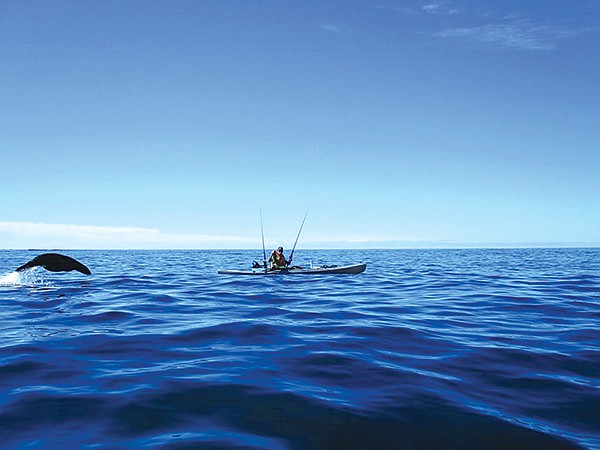
I have hooked and lost two fish I am certain were yellowtail; both times I was spooled on solid, straight-out-to-sea runs. One was just before a three-day Santa Ana wind event; the second the day after, when bait had been blown into the corner and there was a lot of activity in the surf: boils, birds, and sea lions all working along the shore in front of the house. On that occasion, bonito were beaching themselves chasing bait, or they were being chased by the larger predators and being flung onto the sand by the waves. Since then, I have seen no activity I could ascribe to the possibility of yellowtail just out of the surf line.
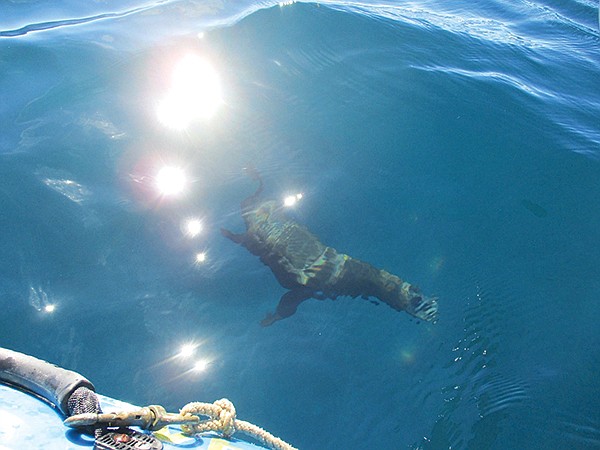
The ‘glittery’ attention-getting arsenal I tend to stick to when fishing the surf zone here is made up of the typical Baja favorites: Krocodiles, Kastmasters, and Megabaits. The Kastmasters and Megabaits work well when the wind gets up and the normally castable Krocodiles can flutter and tumble, losing their speed and causing backlashes. The heavier lures will pull the line out more smoothly in windy conditions.
This stretch of the bay in front of the little house faces more east than south, which puts the late November sunrise directly in the eyes. If there is no morning marine layer, fishing from shore is casting into the sun. As the sun rises, the view into the clear water opens up, with the sun behind the waves as they crest. After a relatively small set on an incoming tide comes the clearest view into the underwater world: yards into the next large wave as it shoulders up. Like a child, I am often held entranced by the momentary aquarium before me. So much so, at times I forget about the wave that will soon be crashing into me. The tug and push of the incoming water colliding into the outgoing wash turns into a workout for legs and midriff, sometimes making it easier to go outside the majority of breakers and stand waist- to chest-deep in water that you have to tread when larger sets come in. Either way, the break is within yards of the beach on a normal day on this mostly sheltered side of the point.

You lose the side-view into the aquarium’ when fishing from outside the break, but gain a view into the often crystal-clear water behind the wave activity. From that vantage point, you can occasionally see followers — usually baitfish that seem to want to swim along with the lure, and rarely, a halibut that won’t quite commit but will come tip-toeing along behind the lure in a manner somewhat reminiscent of a Fred Flintstone maneuver. Many of the bites come from there, just outside the break, and while wading along I’ll invariably see at least a few halibut bolt as I approach. The fish itself is hard to see, but the clouds they raise when swimming away are like their runs when hooked. Imagine the edges of a flag whipping in the wind — the silt cloud will have a ripple to the edges, and when hooked, the run takes on the shuddering rhythm of the undulating flat body of the fish.
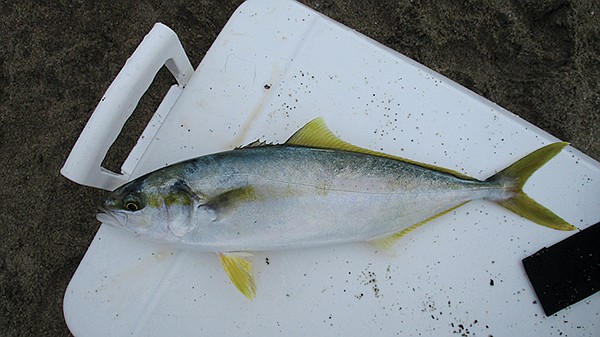
As for launching the kayak on this side of the point, the shore break makes it doable when timed correctly on the flatter days. The best timing is after a wave breaks on the small end of a set. Have the kayak ready and as soon as the wave breaks, hop on and paddle with the outgoing slide of water and out through the next swell before it breaks. If not timed right, disaster can happen. Friend and neighbor Alicia told me of a time when she tried to paddle out and got a black eye for her efforts. Landing also requires good timing; a vacationer recently was blown into the “Jacuzzi,” a spot on the curve of the bay that gets rough enough to create, as Shari Bondy put it, the “Champagne bubbles” that she and Alicia like to play in when doing their near-daily swims.
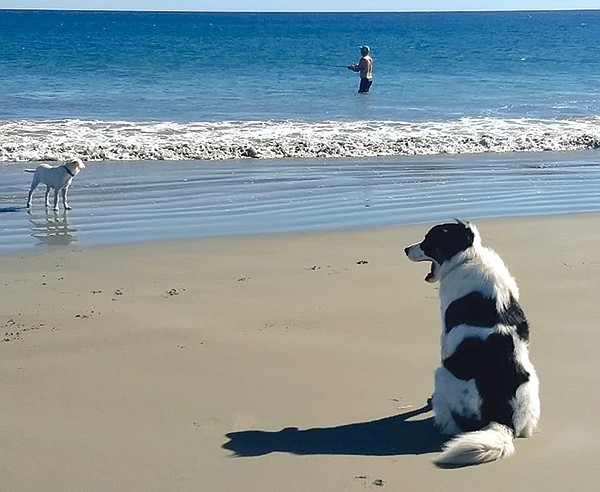
The vacationer had been fishing in a kayak he launched from the west side of the point, but was using a canoe paddle and the one blade was not sufficient to make it back upwind when the afternoon onshore breeze got stiff. The resulting roll up by a larger wave on the beach left him looking for lost gear. Two rods were found the next day on the low tide; one snapped off at the tip from the roll while upright in holders, but one rod and the reels looked salvageable. I have launched and landed a couple times, and can attest that knowing surf technique well is paramount, regardless of how easy it might appear on any given day.
Once out on the kayak, though, there are many options for anglers and sightseers alike. My friend Joe Silva and I fished along the west side of Isla Asunción in water so clear you could count shells on the bottom in 50 feet of water. We caught calico bass to the cacophony of hundreds of sea lions, most of them barking and groaning while basking on the rocks, while some came out to cavort teasingly close to the kayaks. These were mostly pups acting like goofy pre-teens nee-ner nee-nering with “I’m not touching you…”. We also got a couple of close-up looks at sea turtles that were feeding on the sargasso along the edge of the island.
Kayaking here in Bahia Asunción is excellent, if one has the proper paddle, has surf launch and entry technique down, and is not afraid of close encounters with playful sea lions. I love it, but mostly I have been wading, fishing in an aquarium, and casting into the sun for just one more solid run straight out to sea


When the timing is right— when the sun and moon affect light and tide; when the wind and swell affect clarity — the ocean tilts herself to me, and from my perch just 20 feet above and less than a hundred feet away from the high tideline, I can see into her as though peering into an aquarium. I have seen small halibut scurry up and down in the clean face of a shore break, and I have seen what was maybe corbina or yellowfin croaker bolt sideways and out and away. Once, a sea lion and I exchanged glances through the glassy face of a wave before the wave broke and our moment was shattered into shards of white crystal.

Pelicans cruise the surf zone, tucking in tightly along the valleys between the whitewater of the last broken wave and turquoise crest of the next with an aerial accuracy usually only ascribed to aces such as the Blue Angels. It’s when the pelicans suddenly rise, fold their wings and fall ungracefully into the water with beaks open to scoop a baitfish and come up ass over tea kettle that my heart skips a beat. I will often grab the binoculars and watch around them and outside a little, in the deeper water behind the shore break, looking for any inkling of activity from the pelican’s underwater counterparts that also skillfully cruise the shoreline to feed; rarely California yellowtail, more often bonito and halibut. Seasonally, shortfin corvina, California corbina, and yellowfin croaker also cruise within casting distance of shore.

Rods at the ready and binoculars to help with spotting activity. Not a bad way to spend a day.
Since arriving here in Bahia Asunción’s bay side on November 6, I’ve caught dozens of bonito and halibut from the beach. Both species have been small — the bonito maybe to a pound and a half, halibut to 20 inches. As there is no minimum size on the halibut in Mexico, I have eaten a couple in that 18- to 20-inch range. The fillets were thick for their size, the fish having fattened up on the plethora of bait that holds along shore just behind the breaking waves.

Bahia Asunción lies about 515 miles from San Diego, south of the Baja Sur/Baja Norte border. It’s on the south side of the rose thorn-shaped peninsula that juts out from the Pacific side of Baja about halfway between Cabo San Lucas and Tijuana. Folks here prefer their halibut for table fare in the 18-inch size range. One fish will make a basket full of tacos or fillets perfect for a family of four’s main course. For me, there is that feeling of guilt — a fleeting guilt, as I love eating halibut — due to taking a "short." I haven’t always applied California DFW size and catch restrictions while fishing in Mexico, but I do try. Mexico has bag and species limits and license requirements. Following the rules of the fishery in which one is fishing is strictly advised. As for eating a foot-and-a-half halibut, "when in Rome...."

The first time I was here in this little fishing co-op town in Baja California Sur was this past September. I stayed for a few weeks on the sea side of the point and concentrated on calico bass, of which I caught the most and largest that I have in a long time. I caught a yellow within jig stick distance from shore. I fished primarily from my kayak, which I would launch from a sheltered cove just two hundred yards from the Sunset Casita I had rented from Shari Bondy and Juan Arce of La Bufadora Inn. I caught the small five-pound yellowtail while slinging plastics near boiler rocks along the coast.

Here, on the bay-side of the point, I have walked the beach, rod in hand, with my dogs Flash and Taz following along, and the lobos, the dogs of the sea, will be merely a cast away, spy-hopping as if to get a good look at the four-legged dogs and the guy with the glittery lure he’s chucking. They have, like the four-legged variety, evolved along with man, learning to pluck from the edges of his fishing ventures with city coyote-like skill. I’m sure, when they are tagging along, that they are awaiting a hooked, and thus easy-to-steal, fish.

I have hooked and lost two fish I am certain were yellowtail; both times I was spooled on solid, straight-out-to-sea runs. One was just before a three-day Santa Ana wind event; the second the day after, when bait had been blown into the corner and there was a lot of activity in the surf: boils, birds, and sea lions all working along the shore in front of the house. On that occasion, bonito were beaching themselves chasing bait, or they were being chased by the larger predators and being flung onto the sand by the waves. Since then, I have seen no activity I could ascribe to the possibility of yellowtail just out of the surf line.

The ‘glittery’ attention-getting arsenal I tend to stick to when fishing the surf zone here is made up of the typical Baja favorites: Krocodiles, Kastmasters, and Megabaits. The Kastmasters and Megabaits work well when the wind gets up and the normally castable Krocodiles can flutter and tumble, losing their speed and causing backlashes. The heavier lures will pull the line out more smoothly in windy conditions.
This stretch of the bay in front of the little house faces more east than south, which puts the late November sunrise directly in the eyes. If there is no morning marine layer, fishing from shore is casting into the sun. As the sun rises, the view into the clear water opens up, with the sun behind the waves as they crest. After a relatively small set on an incoming tide comes the clearest view into the underwater world: yards into the next large wave as it shoulders up. Like a child, I am often held entranced by the momentary aquarium before me. So much so, at times I forget about the wave that will soon be crashing into me. The tug and push of the incoming water colliding into the outgoing wash turns into a workout for legs and midriff, sometimes making it easier to go outside the majority of breakers and stand waist- to chest-deep in water that you have to tread when larger sets come in. Either way, the break is within yards of the beach on a normal day on this mostly sheltered side of the point.

You lose the side-view into the aquarium’ when fishing from outside the break, but gain a view into the often crystal-clear water behind the wave activity. From that vantage point, you can occasionally see followers — usually baitfish that seem to want to swim along with the lure, and rarely, a halibut that won’t quite commit but will come tip-toeing along behind the lure in a manner somewhat reminiscent of a Fred Flintstone maneuver. Many of the bites come from there, just outside the break, and while wading along I’ll invariably see at least a few halibut bolt as I approach. The fish itself is hard to see, but the clouds they raise when swimming away are like their runs when hooked. Imagine the edges of a flag whipping in the wind — the silt cloud will have a ripple to the edges, and when hooked, the run takes on the shuddering rhythm of the undulating flat body of the fish.

As for launching the kayak on this side of the point, the shore break makes it doable when timed correctly on the flatter days. The best timing is after a wave breaks on the small end of a set. Have the kayak ready and as soon as the wave breaks, hop on and paddle with the outgoing slide of water and out through the next swell before it breaks. If not timed right, disaster can happen. Friend and neighbor Alicia told me of a time when she tried to paddle out and got a black eye for her efforts. Landing also requires good timing; a vacationer recently was blown into the “Jacuzzi,” a spot on the curve of the bay that gets rough enough to create, as Shari Bondy put it, the “Champagne bubbles” that she and Alicia like to play in when doing their near-daily swims.

The vacationer had been fishing in a kayak he launched from the west side of the point, but was using a canoe paddle and the one blade was not sufficient to make it back upwind when the afternoon onshore breeze got stiff. The resulting roll up by a larger wave on the beach left him looking for lost gear. Two rods were found the next day on the low tide; one snapped off at the tip from the roll while upright in holders, but one rod and the reels looked salvageable. I have launched and landed a couple times, and can attest that knowing surf technique well is paramount, regardless of how easy it might appear on any given day.
Once out on the kayak, though, there are many options for anglers and sightseers alike. My friend Joe Silva and I fished along the west side of Isla Asunción in water so clear you could count shells on the bottom in 50 feet of water. We caught calico bass to the cacophony of hundreds of sea lions, most of them barking and groaning while basking on the rocks, while some came out to cavort teasingly close to the kayaks. These were mostly pups acting like goofy pre-teens nee-ner nee-nering with “I’m not touching you…”. We also got a couple of close-up looks at sea turtles that were feeding on the sargasso along the edge of the island.
Kayaking here in Bahia Asunción is excellent, if one has the proper paddle, has surf launch and entry technique down, and is not afraid of close encounters with playful sea lions. I love it, but mostly I have been wading, fishing in an aquarium, and casting into the sun for just one more solid run straight out to sea
Comments